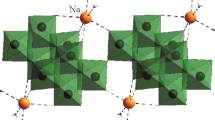Abstract
Three new heptamolybdates ofn-alkylammonium have been synthesized, with the general formula: (BH)6[Mo7O24]·3H2O, where B=n-butyl-,n-pentyl-, andn-hexylamine (hereafter abbreviated as BUTMO, PENTMO, and HEXMO, respectively). Crystal structure analyses of these compounds show that all of them are isostructural and crystallize in the monoclinic system, the space group beingP21/n,Z=4. Crystal data for PENTMO are: (C5H14N)6[Mo7O24]·3H2O,a=17.085(2),b=31.344(4),c=11.487(12) Å,β=93.04(3)°,V=6143(6) Å3,F(000)=3288,D x =1.77, D0=1.78(1) Mg·m−3,R=0.059, andR w =0.066 for 5526 observed reflections. Only slight differences in cell dimensions have been observed for these compounds, except for the parameterb which is significantly different in all of them. Thermogravimetric studies show that the compounds contain three water molecules. IR spectra indicate that the organic bases are protonated and the polyanion presents the well-known infrared spectrum for heptamolybdates in the solid state. The structure solution confirms that the compound PENTMO contains discrete [Mo7O24]6− anions, (C5H14N)+ cations, and water molecules, connected through hydrogen bonds; the distinguishing features of the compound PENTMO are its extensive hydrogen bonding. The cations and the water molecules are positioned so as to be able to form hydrogen bonds with either molybdate oxygen atoms or water oxygen atoms. The proposed strong hydrogen bonding interactions appear to stabilize the structure. Some of these hydrogen bonds can play an important role in the possible photochromism of this compound.
Similar content being viewed by others
References
Cromer, D. T., and Waber, J. T. (1974)International Tables for X-ray Crystallography. J. A. Ibers, and W. C. Hamilton, eds. (Kynoch Press, Birmingham, England), Vol. IV, Table 2.2A, pp. 72 ff.
Don, A., and Weakley, T. R. J. (1981)Acta Crystallogr. B 37, 451.
Evans, H. T., Jr., Gatehouse, B. M., and Leverett, P. (1975)J. Chem. Soc. Dalton Trans., 505.
Lindqvist, I. (1950)Ark. Kemi 2, 325.
Lyhamn, L. (1982)Acta Chem. Scand. A 36, 595.
Main, P., Fiske, S. J., Hull, S. H., Lessinger, L., Germain, G., Declerq, J.-P. and Woolfson, M. M. (1980)Multan 80 (Universities of York, England, and Louvain-la-Neuve, Belgium).
Martínez-Ripoll, M., and Cano, F. H. (1975)Pesos (Instituto Rocasolano, CSIC, Madrid, Spain).
Muetterties, E. L., and Guggenberger, L. J. (1974)J. Am. Chem. Soc. 96, 1748.
Ohashi, Y., Yanagi, K., Sasada, Y., and Yamase, T. (1982)Bull. Chem. Soc. Jpn. 55, 1254.
Román, P., and Gutiérrez-Zorrilla, J. M. (1985)J. Chem Educ. 62, 167.
Román, P., Gutiérrez-Zorrilla, J. M., Esteban-Calderón, C., Martínez-Ripoll, M., and García-Blanco, S. (1985a)Polyhedron 4, 1043.
Román, P., Gutiérrez-Zorrilla, J. M., Martínez-Ripoll, M., and García-Blanco, S. (1985b)Z. Kristallogr. 173, 169.
Román, P., Gutiérrez-Zorrilla, J. M., Martínez-Ripoll, M., and García-Blanco, S. (1985c)Z. Kristallogr. 173, 283.
Román, P., Gutiérrez-Zorrilla, J. M., Martínez-Ripoll, M., and García-Blanco, S. (1986a)Acta Crystallogr. C. 42, 956.
Román, P., Gutiérrez-Zorrilla, J. M., Martínez-Ripoll, M., and García-Blanco, S. (1986b)Polyhedron 5, 1799.
Román, P., Gutiérrez-Zorrilla, J. M., Martínez-Ripoll, M., and García-Blanco, S. (1986c)Transition. Met. Chem. 11, 143.
Román, P., Gutiérrez-Zorrilla, J. M., Martínez-Ripoll, M., and García-Blanco, S. (1987a)J. Crystallogr. Spectrosc. Res. 17, 109.
Román, P., Gutiérrez-Zorrilla, J. M., Martínez-Ripoll, M., and García-Blanco, S. (1987b)Trans. Met. Chem.,12, 159.
Schuster P. (1976) InThe Hydrogen Bond—Recent Developments in Theory and Experiment, P. Schuster, G. Zundel, and C. Sandorfi, (eds.) (North-Holland, Amsterdam), Vol. 2, pp. 395–456.
Sjöbom, K., and Hedman, B. (1973)Acta Chem. Scand. 27, 3673.
Stewart, J. M. (1976) TheXray 76 System, Tech. Rept. TR-446, Computer Science Center University of Maryland, College Park, Maryland.
Walker, N., and Stuart, D. (1983)Acta Crystallogr. A 39, 158.
Author information
Authors and Affiliations
Rights and permissions
About this article
Cite this article
Román, P., Gutiérrez-Zorrilla, J.M., Luque, A. et al. Crystal structure and spectroscopic study of polymolybdates. The crystal structure and bonding of hexakis(n-pentylammonium) heptamolybdate(VI) trihydrate. Journal of Crystallographic and Spectroscopic Research 18, 117–131 (1988). https://doi.org/10.1007/BF01181904
Received:
Revised:
Issue Date:
DOI: https://doi.org/10.1007/BF01181904




